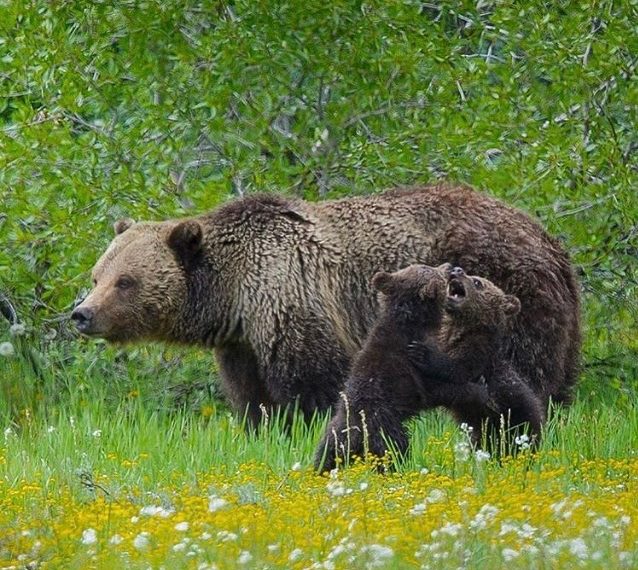Thursday, January 31, 2019
Contact:
Bonnie Rice, Sierra Club, (406) 640-2857, bonnie.rice@sierraclub.org
Andrea Santarsiere, Center for Biological Diversity, (303) 854-7748, asantarsiere@biologicaldiversity.org
Taylor Jones, WildEarth Guardians, (720) 443-2615, tjones@wildearthguardians.org
Kirsten Peek, the Humane Society of the United States, (301) 548-7793, kpeek@humanesociety.org
Kristin Combs, Wyoming Wildlife Advocates, (307) 413-4116, kristin@wyowild.org
Daniela Arellano, Natural Resources Defense Council, (310) 434-2304, darellano@nrdc.org
BOZEMAN, Mont.– Conservation groups today called on the Interagency Grizzly Bear Committee’s Yellowstone Ecosystem Subcommittee to update a decade-old report on grizzly bear conflict prevention after a record number of bears died last year.
In a letter to the committee, the six groups noted that the 2009 report is both outdated and largely unimplemented. The organizations asked the committee to develop additional recommendations to prevent conflicts between bears, people and livestock.
The Sierra Club, Center for Biological Diversity, the Humane Society of the United States, WildEarth Guardians, Natural Resources Defense Council (NRDC) and Wyoming Wildlife Advocates cited the record number of 65 grizzly bear mortalities in 2018 and the lack of implementation of nonlethal prevention measures.
“Hundreds of the Yellowstone region’s treasured grizzly bears have needlessly died in just the last few years,” said Bonnie Rice, senior representative for Sierra Club’s Our Wild America Campaign. “There are many effective ways to prevent conflicts, and our state and federal agencies must do more. Yellowstone’s isolated grizzly bear population is still vulnerable and stronger conflict prevention measures must be implemented throughout the region to promote coexistence and keep bears, people and property safe.”
The letter stressed the urgency for the committee to take action before this year’s hunting season, when many conflicts occur. According to reporting from the U.S. Geological Survey, nearly 250 grizzly bears are known to have died in the Yellowstone region just since 2015. Almost all deaths were attributable to human-related causes.
Specifically, the groups called on the subcommittee to update the 2009 mortality and conflicts report and prepare a detailed report on the review team’s progress with conflict prevention recommendations.
“This outdated grizzly conflict report is ineffective and does next to nothing to stop the deaths of America’s beloved Yellowstone grizzlies,” said Andrea Santarsiere, a senior attorney with the Center for Biological Diversity. “If nonlethal measures aren’t implemented immediately, more grizzlies will needlessly die.”
The organizations also asked that the subcommittee consider additional recommendations to prevent conflicts, including: creation of a publicly available database of encounters and mortalities, including at least the past five years; and a determination of what additional research is necessary to identify how to prevent conflicts.
“It’s crucial that we end the unnecessary deaths of these iconic bears,” said Taylor Jones, endangered species advocate for WildEarth Guardians. “Updating the science and establishing best practices for nonlethal coexistence is key to the survival of the Yellowstone population of grizzlies.”
“Grizzly bears cause nominal livestock losses, data from governmental entities show, amounting to a fraction of one percent of the sheep and cattle inventories in the Northern Rockies. Yet, the constant killings of these federally protected bears is outsized in comparison. It’s long past time for the federal government to act on behalf of the American people to protect grizzly bears,” said Wendy Keefover, native carnivore protection manager for the Humane Society of the United States.
“The mortality rates of grizzlies over the past few years have revealed a deeply disturbing trend. Too many bears are dying, and it’s time for managers and communities alike to seriously commit to the most effective methods for conflict prevention,” said Kristin Combs of Wyoming Wildlife Advocates. “The first step on that path is for agencies to update this report. Conflict prevention is the path forward.”
“We’ve worked shoulder to shoulder with landowners and wildlife officials to install electric fencing and use other effective, nonlethal methods to reduce human-grizzly bear conflicts,” said Zack Strong, senior attorney and wildlife advocate with the Natural Resources Defense Council. “It’s past time to update the outdated conflicts report, work together to put the new recommendations into practice, and reduce losses for people and bears alike.”
The full letter can be found here.
Photo: Tina Smith

